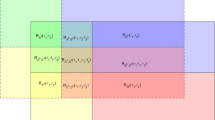Abstract
In this paper, we analyze the performance of vector perturbation (VP) precoded multiuser multiple-input multiple-output (MU-MIMO) systems in a composite fading channel including not only small-scale Rayleigh fading but also large-scale fading for getting useful conclusion in a more realistic scenario. Through the derivation of average power of sphere-encoded vectors, we obtained the closed-form expression of the sum rate tight lower bound of VP precoded MU-MIMO systems, which is a function of the number of transmit/receive antennas, transmit power and large-scale fading parameters. From the analytical expression of sum rate and error probability bounds, it is concluded that the performance of VP precoded MU-MIMO systems deteriorates severely when intended users experience very different large-scale fadings. Simulation results validate our analysis.




Similar content being viewed by others
References
Caire, G., & Shamai, S. (2003). On the achievable throughput of a multiantenna Gaussian broadcast channel. IEEE Transaction on Information Theory, 43(7), 1691–1706.
Vishvanath, S., Jindal, N., & Goldsmith, A. (2003). Duality, achievable rates, and sum-rate capacity of Gaussian MIMO broadcast channels. IEEE Transaction on Information Theory, 49(10), 2658–2668.
Peel, C. B., Hochwald, B. M., & Swindlehurst, A. L. (2005). A vector-perturbation technique for near-capacity multiantenna multiuser communication-part I: Channel inversion and regularization. IEEE Transactions on Communications, 53(1), 195–202.
Fischer, R. F. H. (2002). Precoding and signal shaping for digital transmission. New York: Wiley.
Sonobe, S., Tsukamoto, S., Maeda, T., Yano, K., Ban, H., Uno, M., & Kobayashi, K. (2013). Field experiments of LTE-Advanced-based \(8\times 8\) multiuser MIMO system with vector perturbation. In: The 9th International workshop on wireless network measurements (WiNMee 2013), pp. 83–88.
Chen, R., Li, C., & Li, J. (2012). Distributed spatial interference coordination for IEEE 802.11n wireless networks. IEICE Transactions on Communications, E95–B(4), 1297–1299.
Hochwald, B. M., Peel, C. B., & Swindlehurst, A. L. (2005). A vector perturbation technique for near capacity multiantenna multiuser communication-part II: Perturbation. IEEE Transactions on Communications, 53(3), 537–544.
Schmidt, D., Joham, M., & Utschick, W. (2007). Minimum mean square error vector precoding. European Transactions on Telecommunications, 19, 219–231.
Han, H.-S., Park, S.-H., Lee, S., & Lee, I. (2010). Modulo loss reduction for vector perturbation systems. IEEE Transactions on Communications, 58(12), 3392–3397.
Choi, L.-U., & Murch, R. D. (2004). A transmit preprocessing technique for multiuser MIMO systems using a decomposition approach. IEEE Transactions on Wireless Communications, 3(1), 20–24.
Spencer, Q. H., Swindlehurst, A. L., & Haardt, M. (2004). Zero-forcing methods for downlink spatial multiplexing in multiuser MIMO channels. IEEE Transactions on Signal Processing, 52(2), 461–471.
Chae, C.-B., Shim, S., & Heath, R. W. (2008). Block diagonalized vector perturbation for multiuser MIMO systems. IEEE Transactions on Wireless Communications, 7(11), 4051–4057.
Chen, R., Li, C., Li, J., & Zhang, Y. (2012). Low complexity user grouping vector perturbation. IEEE Wireless Communications Letters, 1(3), 189–192.
Chen, R., Li, J., Li, C., & Liu, W. (2013). Multi-user multi-stream vector perturbation precoding. Wireless Personal Communications, 69(1), 335–355.
Ryan, D. J., Collings, I. B., Clarkson, I. V. L., & Heath, R. W, Jr. (2009). Performance of vector perturbation multiuser MIMO systems with limited feedback. IEEE Transactions on Communications, 57(9), 2633–2644.
Razi, A., Ryan, D. J., Collings, I. B., & Yuan, J. (2010). Sum rates, rate allocation, and user scheduling for multi-user MIMO vector perturbation precoding. IEEE Transactions on Wireless Communications, 9(1), 356–365.
Conway, J. H., & Sloane, N. J. A. (1993). Sphere packings, lattices and groups (2nd ed.). New York: Springer.
Tulino, A. M., & Verd, S. (2004). Random matrix theory and wireless communications. Communications and Information Theory, 1(1), 1–182.
Cover, T. M. (2006). Elements of information theory. New York: Wiley.
Acknowledgments
This work was supported by National Natural Science Foundation of China (61301168,61271176,61571350), Natural Science Basic Research Plan in Shaanxi Province of China (2013JQ8001), Fundamental Research Funds for the Central Universities (K5051201001), National Science and Technology Major Project (2011ZX03001-007-01,2013ZX03004007-003), Open Research Fund of National Mobile Communications Research Laboratory (2012D01) and the 111 Project (B08038).
Author information
Authors and Affiliations
Corresponding author
Rights and permissions
About this article
Cite this article
Chen, R., Li, C., Li, J. et al. Performance of Vector Perturbation MU-MIMO Systems in a Composite Fading Channel. Wireless Pers Commun 89, 135–147 (2016). https://doi.org/10.1007/s11277-016-3256-2
Published:
Issue Date:
DOI: https://doi.org/10.1007/s11277-016-3256-2




